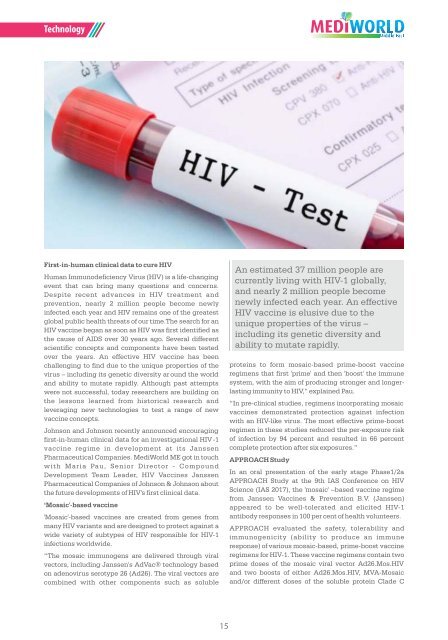Mediworld Final Draft for Print
You also want an ePaper? Increase the reach of your titles
YUMPU automatically turns print PDFs into web optimized ePapers that Google loves.
Technology<br />
First-in-human clinical data to cure HIV<br />
Human Immunodeficiency Virus (HIV) is a life-changing<br />
event that can bring many questions and concerns.<br />
Despite recent advances in HIV treatment and<br />
prevention, nearly 2 million people become newly<br />
infected each year and HIV remains one of the greatest<br />
global public health threats of our time.The search <strong>for</strong> an<br />
HIV vaccine began as soon as HIV was first identified as<br />
the cause of AIDS over 30 years ago. Several different<br />
scientific concepts and components have been tested<br />
over the years. An effective HIV vaccine has been<br />
challenging to find due to the unique properties of the<br />
virus – including its genetic diversity ar ound the world<br />
and ability to mutate rapidly. Although past attempts<br />
were not successful, today researchers are building on<br />
the lessons learned from historical research and<br />
leveraging new technologies to test a range of new<br />
vaccine concepts.<br />
Johnson and Johnson recently announced encouraging<br />
first-in-human clinical data <strong>for</strong> an investigational HIV-1<br />
vaccine regime in development at its Janssen<br />
Pharmaceutical Companies. MediWorld ME got in touch<br />
with Maria Pau, Senior Director - Compound<br />
Development Team Leader, HIV Vaccines Janssen<br />
Pharmaceutical Companies of Johnson & Johnson about<br />
the future developments of HIV's first clinical data.<br />
‘Mosaic'-based vaccine<br />
'Mosaic'-based vaccines are created from genes from<br />
many HIV variants and are designed to protect against a<br />
wide variety of subtypes of HIV responsible <strong>for</strong> HIV-1<br />
infections worldwide.<br />
“The mosaic immunogens are delivered through viral<br />
vectors, including Janssen's AdVac® technology based<br />
on adenovirus serotype 26 (Ad26). The viral vectors are<br />
combined with other components such as soluble<br />
An estimated 37 million people are<br />
currently living with HIV-1 globally,<br />
and nearly 2 million people become<br />
newly infected each year. An effective<br />
HIV vaccine is elusive due to the<br />
unique properties of the virus –<br />
including its genetic diversity and<br />
ability to mutate rapidly.<br />
proteins to <strong>for</strong>m mosaic-based prime-boost vaccine<br />
regimens that first 'prime' and then 'boost' the immune<br />
system, with the aim of producing stronger and longerlasting<br />
immunity to HIV,” explained Pau.<br />
“In pre-clinical studies, regimens incorporating mosaic<br />
vaccines demonstrated protection against infection<br />
with an HIV-like virus. The most effective prime-boost<br />
regimen in these studies reduced the per-exposure risk<br />
of infection by 94 percent and resulted in 66 percent<br />
complete protection after six exposures.”<br />
APPROACH Study<br />
In an oral presentation of the early stage Phase1/2a<br />
APPROACH Study at the 9th IAS Conference on HIV<br />
Science (IAS 2017), the 'mosaic' –based vaccine regime<br />
from Janssen Vaccines & Prevention B.V. (Janssen)<br />
appeared to be well-tolerated and elicited HIV-1<br />
antibody responses in 100 per cent of health volunteers.<br />
APPROACH evaluated the safety, tolerability and<br />
immunogenicity (ability to produce an immune<br />
response) of various mosaic-based, prime-boost vaccine<br />
regimens <strong>for</strong> HIV-1. These vaccine regimens contain two<br />
prime doses of the mosaic viral vector Ad26.Mos.HIV<br />
and two boosts of either Ad26.Mos.HIV, MVA-Mosaic<br />
and/or different doses of the soluble protein Clade C<br />
15

















